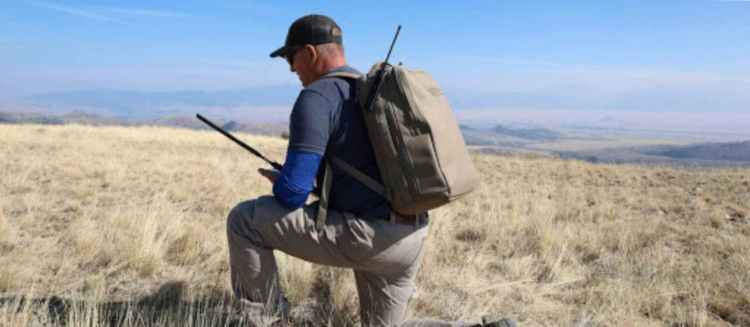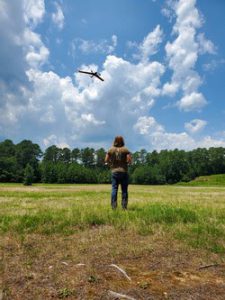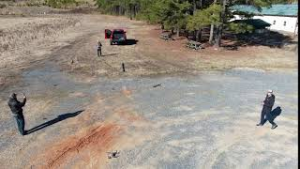Tough Stump solutions take the “stumped” out of tactical edge connectivity

Network-connected mobile devices, applications, and other digital technologies are crucial components of almost every military operation or mission. Unfortunately, operations are often executed in environments that lack the terrestrial network infrastructures capable of providing the necessary connectivity to these mission-critical technologies.
When warfighters are deployed in off-grid and austere environments at the tactical edge, communications and situational awareness among mission team members is nearly impossible.
Here to step in and solve these connectivity challenges is Tough Stump. Tough Stump is a Service Disabled Veteran-Owned Small Business (SDVOSB) that provides technology integration to meet warfighter remote sensing, situational awareness, and mobile communication requirements. Through mobile mesh networking, Tough Stump is supplying today’s military with the mission-specific connectivity solutions necessary for successful operations.
The Last Mile had a chance to sit down with Tough Stump’s Cell Leader of SUAS & Tactical Networking, Zeb Jaillet, to examine the military’s current off-grid communications challenges, and how mobile mesh networking serves as a standout solution for situational awareness and connectivity at the tactical edge.
The Last Mile (TLM): Tell our readers a little bit about Tough Stump. What does the company do? How did it get its start and where did it get its name?

Zeb Jaillet: Tough Stump is a SDVOSB, based out of Southern Pines, North Carolina. The owner, Jarrett Heavenston, is a former U.S. Air Force Special Operations combat controller. I am also a former U.S. Special Operations combat controller.
During Jarrett’s last couple of years in the Air Force, he began using agricultural mapping drones for military purposes. And he found that this was an opening for a business plan. He incorporated using agricultural mapping drones to create maps for military purposes. One could create brand new maps that are three hours old, as opposed to pulling an older map of the same area.
In 2014, he came up with a concept, partnered up with a few guys, and launched the company. It was incorporated in 2016.
As for the company name, I think great companies have an agnostic name. On Jarrett’s land, he has this tree that was over 100 years old. It fell over and died a couple years before he owned the property. It was struck by lightning and caught fire. He tried to chop it down, but it was half petrified. And he said, “Man, that is one tough stump! You know what? That’s actually a pretty cool name!”
Being Tough Stump, you can’t pin us down with one job title. If we were, “Drone Flying Company Four,” we’re always going to be, “Drone Flying Company Four.” But being Tough Stump gives us a lot of flexibility to move around the technology world. That’s where it came about.
I joined the company two years ago, after retiring with 24 years in the Air Force. The company was still based in tactical mapping through their drone flying program. I was brought in to find a different venture for the tech company. I spent a lot of time incorporating RF signatures and flying a lot of unmanned aerial vehicles (UAV). They brought me on to continue RF signature reading and using UAVs. And there are a lot of demand signals.
I’ve spent this past year doing a lot of we call “tactical networking” or “off unstructured networking,” which is where mesh networking comes in on top of mobile ad hoc networks. And I’ve been teaching military units, regular civilian folks, and companies how to fly or use UAVs in their mission or application.
TLM: Tough Stump seems to take pride in finding simple solutions to complex military problems. What kinds of problems are we talking about? How can simple solutions possibly solve these large challenges?

Zeb Jaillet: “Simple” is in the eye of the beholder. For example, after that hurricane that devastated the Bahamas, there was a nonprofit organization that went down there. They sent nurses, doctors, and first responders to help out with the island. But they would just send them out with a pat on the back and a, “Good luck. We’ll see you in a couple days.”
So, the military supporting unit came to us and asked, “How would you create a network or a means to keep communications with these guys?” Well, you could set up a manmade network and then – through a couple of mesh networking antennas – create a reach back. You could be in Florida and have a direct line of communications with a devastated island that doesn’t have any supported cellular towers, internet, or network just by creating your own!
That’s the purpose. Now we go out with these organizations and set up scenarios where we’ll create a network for them. They have to be prepared for the worst-case scenario, if there are no cell towers and all radios are down. There is a simple solution to a complex problem like communication.
TLM: Tough Stump was founded by a veteran and works hard to hire veterans. Why is it important for a company like this to hire veterans? What do they bring to the table?
Zeb Jaillet: The veterans that we hire are high caliber. Most of the employees came from a Special Operations Command, which puts you through at least one to two more selection cycles, physically, mentally, and psychologically. The people that work here already had a vetted background. When we’re hiring people, it’s easy to go straight to veterans, because they’ve already proven themselves in certain situations. I don’t have to wonder what their core values and competencies are.
TLM: As a veteran that works closely with the military, what are the largest communications challenges you see in the military today? How reliable are their communications and situational awareness tools in theater and in off-the-grid locations at the tactical edge?
Zeb Jaillet: All the answers are out there for a lot of the military units, from your basic infantry lines to your support soldiers, all the way up to your guys that are doing night raids.
But the answers for off-grid or tactical networking are out there and available to them. But it’s the exposure that’s the problem.
A lot of us know how to use our phones. We all know how to make a phone call, send a text message, and check an app. But do you know how to go really deep in your phone? The same thing applies to military units.
They know how to use radio systems. They’re comfortable with their UHF line-of-sight. But did they know that inside a lot of these radios they can turn a GPS on and can connect to an end-user device? A smartphone? You can really enable your entire force just by using—what we consider—a common means to create communication architecture.
TLM: Tough Stump has been a large proponent of both ATAK and mobile mesh networking. What are the use cases that you see for ATAK in today’s military? What useful capabilities and applications does it have for the warfighter?
Zeb Jaillet: Specifically for the military, it’s just the core competencies of ATAK itself. Situational awareness, a moving map, and the ability to share data quickly, accurately, and securely. Those are the five core tenants of ATAK. They are applicable to every military unit, from logistics, special operators to transportation fighters. It syncs everybody on the same page, and it opens up everybody’s situational awareness. It enables leaders at all levels to make informed decisions faster. That is great for safety and awareness.
It’s also a real risk mitigator. It’s another way to track battle and understand where all of your good guys are, and how to prevent that fratricide on the military side.

TLM: Are there any particular ATAK plugins that you find interesting or useful that add solid functionality to the application?
Zeb Jaillet: For me, it’s kind of a flavor of the month thing. Right now, we have an Android Tactical Object Surveillance (ATOS) plugin. You add one additional radio Bluetooth to it, and you can track up to 100 tags. This can be given to a user who doesn’t need to have a smartphone and just wants to do their job. It can be form shaped into a slap bracelet. And you just put a tag on them and forget them.
And with a server, you track an endless amount of tags.
It’s fun because ATAK is always changing. Every four months, there’s a new build that comes out, and they tweak things just a little bit. It’s forever exploring every plugin, every toolbar, every reaction, and overflow menu, so I’m on top of my game.
TLM: Why is mobile mesh networking useful for today’s military? What does it enable and how does it help?
Zeb Jaillet: It’s a lightweight, fairly inexpensive means to have great situational awareness for a military battlefield, but really any missions in general.
For a software-defined radio, you can spend anywhere between $1,000 to $25,000 for one radio. You can get excellent data. You can pass an excellent amount of data between the software-defined radios and those upper UHF frequencies. But what do you really need it for?
This is where the mesh solution comes in. It won’t pass as much data, but it delivers situational awareness. It is lightweight, inexpensive, and it’s easy to use.
TLM: What have your experiences been like utilizing ATAK and mobile mesh? Any interesting anecdotes or success stories you’d like to share?
Zeb Jaillet: We did an internal company trip, right when I joined [the company]. I took it upon myself to demonstrate how far I can push it. We had some goTenna Pro X’s, and we used MPU5s. We went out in West Texas where there are no cellular towers or routers. You are in cold blackness.
I used ATAK in 3D mode with digital terrain elevation data, and I did some analysis on where my higher peaks were. I created a line-of-sight bounce. From a 3,000 foot peak to a 2,600 foot peak, and then on down the other side of the north side, another peak. I set up MANET radios, tethered with my goTenna Pro X’s tuned to UHF. And we got 9 kilometers from termination to start point, without any other supporting network.
And what’s funny was we had a guy with a goTenna Pro X strapped to a UAV. The UAV was outside of the MANET network range. The goTenna Pro X mesh network would still bring in that position location information data through goTenna Pro X, into the MANET, and then back to the operation center where you can track everybody.
TLM: Are there any new exciting projects or events you’re working on the horizon?
Zeb Jaillet: Yes! We’re actually going up to the U.S. Air Force Research Laboratory. We’re demonstrating the ATOS tracking plugin through a MANET network, the 5G network up there, and through a mesh network. We’ll have our goTenna Pro X’s up there too. That’s coming up in July.
We have ATAK classes going on through the rest of summer. It’s exciting. I just wish we had ATAK, mesh networks, and MANET networks when I was in my prime during my service. I’m 45 now, and I joined the military in 1995. We didn’t have a lot of this technology. Looking in the rearview mirror, it could have definitely assisted us and saved lives.
We are also going out to Montana. Tough Stump is hosting a tech demo, and we’re having vendors come out and demonstrate their abilities to their clients. We will bring in our MANET mesh networks, UAVs, and a couple other vendors out there. That will happen July 19th – 23rd. We are pretty excited about the fun, busy summer ahead!
Watch Tough Stump’s latest tutorial on how to set up goTenna Pro X relays
For more information about Tough Stump, visit their website here or fill out the contact form here.







No Comment